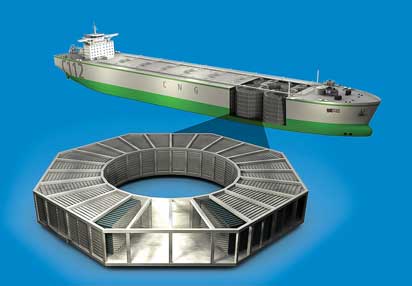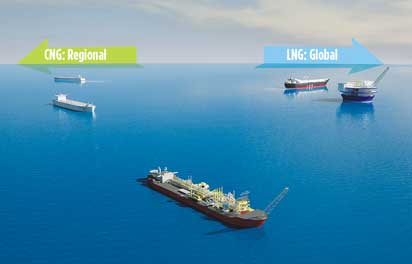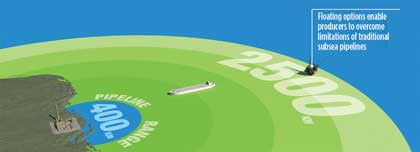Combine FLNG and CNG vessels to exploit stranded gas reserves
D. Stenning, L. Ward and M. Trebble, Sea NG Corp., Calgary, Canada; and
F. Major, Sevan Marine ASA, Arendal, Norway
In the drive to monetize stranded offshore gas fields, LNG and CNG are often thought of as competitors. This perspective misses a significant opportunity for synergy. CNG shipping is most effective in supplying regional gas markets, while LNG shipping is most efficient at supplying global markets. Together, CNG and LNG can efficiently serve both the local and global markets, adding significant value to offshore gas field development.
Subsea pipelines are the accepted method of delivering offshore gas to local markets. However, in cases where the distance is too long, the seabed too difficult, or the water depth too great, a subsea pipeline can quickly become uneconomical. Pipeline economics can be further complicated by a relatively short field life, since they cannot be moved. Marine CNG overcomes most of these difficulties and effectively reaches many local and regional markets that cannot be joined by pipeline.
FLNG and CNG working together. To overcome the shortcomings of subsea pipelines, industry first turned to the development of floating liquefaction facilities, or FLNG ships. However, FLNG vessels are proving to be complex and expensive, especially when the gas requires significant processing before liquefaction.
The American Bureau of Shipping (ABS) recently provided full class design approval for a CNG ship that uses very large CNG pressure vessels (Fig. 1) made with inexpensive, small-diameter coiled steel pipe (a “coiled-pipe” CNG ship1). This design dramatically reduces the cost of CNG shipping while offering exceptional safety and simplicity. The coiled-pipe CNG ship is designed to be constructed using normal shipyard construction techniques, with Korea’s largest shipyards qualified as builders. Therefore, the risk for significant cost and schedule overruns on a marine CNG project is limited.
 |
|
Fig. 1. CNG ship with large pressure vessels. |
Each of the pipe coils are themselves contained with a framework and are integrated into the ship like any other block, to form part of the ship’s structure. With the advent of a CNG ship receiving full approval from ABS, CNG shipping is gaining industry acceptance as a viable and flexible option for the transportation of natural gas over water.
CNG-receiving facilities have a very small footprint, since no regasification is needed. In circumstances where an absolute minimum shore impact is required, the scavenging compression can be installed on each of the ships, so that the only required onshore facility is a pipeline connection.
Loading CNG containers. The ability to efficiently load a series of CNG containers, each comprising a large coil of small-diameter pipe, within the hold of a ship is key to the economics of the overall value chain of marine CNG (Fig. 2). Loading large quantities of natural gas into a coiled-pipe CNG ship is unique and requires a detailed evaluation through computer simulation and physical tests. Here, the process of loading coiled-pipe CNG ships is discussed from a gas thermodynamics perspective.
 |
|
Fig. 2. Sevan Marine FPSO with traditional oil tanker. |
Gas conditioning. Gas is generally treated prior to injection into the CNG containers to avoid the possibility of liquid formation inside. This generally means that the gas cricondentherm is kept below the minimum gas temperature within the CNG containers, which ranges from −15°C to 10°C, and the water content is kept below 7 lb/MMscf.
Gas loading. Loading and unloading of the coiled-pipe CNG containers offers some interesting processing challenges due to the unsteady-state nature of the process. Ships arrive at a loading facility with a heel pressure as low as 150 psig. The conditioned gas is compressed into the ship through either a single-header or multiple-header system, up to a pressure of 4,000 psig.
Compressor aftercooling is accomplished with air or water cooling, although, in some instances, it may be economic to refrigerate the feed gas to reduce the maximum stored gas temperature, therefore increasing the density of the carried gas. The gas temperature within the coiled pipe is kept above −15°C in all instances to avoid lowering the steel temperature (including a safety factor) into a region that could affect its ductility.
Thermal effects. The filling of the coiled pipe causes a temperature rise inside the pipe of approximately 40°C when aftercooling by air coolers is employed. This temperature rise is calculated by a simple energy balance and is mitigated by the thermal capacitance of the encasing steel. This energy rise was confirmed by pilot plant testing.
As well as the change in the overall average temperature, the temperature gradient along the length of the coiled pipe is also of interest. By using dynamic simulation, the simulated thermal profile along the length of the coiled pipe was matched to the pilot plant data. The conclusion of the study was that the magnitude of the transient temperature profile was relatively small and was mitigated over a reasonably short time frame. As a result, utilized steady-state simulation can be used to calculate the overall temperature rise during filling, as well as the temperature drop upon depressurization at the receiving facility.
For a typical application, the drop in temperature at the receiving facility is quite close to the temperature rise upon filling.
Temperature control. Management of the temperature within the coiled pipe over an entire cycle has a few control elements. If the temperature trend is increasing over several cycles, it is possible to reduce the average temperature by either aftercooling more, or by raising the heel pressure. Alternately, if the temperature trend is decreasing, it is a simple matter to aftercool less, resulting in hotter feed gas entering the coiled pipe.
Evaluating the thermal behavior of the gas during ship loading presented some interesting challenges during the design process. Engineering and testing have shown that CNG ships using coiled pipe as the CNG container can be loaded in an efficient and cost-effective manner, using standard approaches to design and implementation.
Exploiting large and small gas fields. CNG ships, used in conjunction with a conventional gas FPSO, such as a floating vessel or a fixed platform, make it possible to exploit smaller gas fields, provided there are regional gas markets. For large gas fields capable of supporting an FLNG project, marine CNG ships can still serve the local and regional markets, while LNG ships can serve the global markets.
One way to exploit a large gas field is to first deploy a gas processing unit and CNG ships to serve local/regional markets, and then to add an FLNG vessel later to serve global markets. The gas FPSO will provide processed gas to the FLNG vessel, thereby saving considerable cost and complexity. Using this method, it is possible to create a standardized FLNG vessel that can be moved from one gas field to another, since it will always receive gas processed to an LNG specification. Serving local/regional markets has considerable appeal (Fig. 3), since these markets are often using expensive liquid fuel or polluting coal. Solving the local gas supply issues can often enhance the acceptability of an FLNG solution to the local authorities.
 |
|
Fig. 3. Floating options enable producers to overcome limitations of traditional |
The gas FPSO, CNG ships and FLNG vessel can be redeployed from field to field, allowing the sequential development of multiple smaller gas reserves that would be impossible to exploit using pipelines or FLNG alone (Fig. 4).
 |
|
Fig. 4. Conceptual FLNG/FCNG configuration. |
Technology synergies. CNG technology should not be seen as a competitor to LNG, but as a complementary technology. A CNG ship effectively serves the function of a portable floating pipeline; it can be deployed in any water depth and under any seabed conditions, and its economic reach is much longer than a subsea pipeline. Gas fields once considered stranded can now be developed. By restructuring the natural gas supply chain to include CNG ships, the boundaries of what is politically, economically and technically feasible expand dramatically.
LNG and CNG can partner to extend the lifespan of onshore LNG plants by providing new sources of feedstock and expanding the scope of FLNG applications by adding regional CNG markets. Rethinking the transportation of natural gas opens hundreds of new opportunities to deliver offshore gas reserves to a range of consumers. GP
Note
1Sea NG Corp. has received full class approval for its Coselle CNG ship design from the ABS. The Coselle is a patented CNG pressure vessel that is a large coil of 6-in. pipe contained within a carousel-like structure.
 |
David G. Stenning is the president and COO of Sea NG Corp. He has 30 years of experience in the international energy industry. He has managed innovative marine projects from initial conception through implementation. Prior to co-founding Sea NG, he led marine CNG initiatives at two major international companies. Mr. Stenning holds degrees in engineering and economics.
 |
Lyndon Ward is the director of marketing for Sea NG Corp. He is responsible for the planning, development and implementation of marketing and communication activities for the company and the Sea NG Alliance. Previously, he spent over a decade as a management consultant, advising new ventures in the energy and services sector. Mr. Ward has a bachelor of commerce degree from the University of Calgary in Canada.
Mark Trebble is head of process engineering at Sea NG Corp. He has over
30 years of industrial experience, primarily focused on the design and operation of cryogenic processes for extraction and fractionation of liquids from natural gas. He is a thermodynamics and simulation expert and holds two US patents and two international patents. Dr. Trebble’s academic career included teaching chemical engineering at the University of Calgary in Canada and a professorship at Curtin University in Perth, Australia, which led to the publication of more than 30 papers. More recently, he was the Gas Technology Program Leader for the Western Australia Energy Research Alliance (WAERA).
Fredrik Major is the vice president of business development at Sevan Marine.
He holds a BSc degree in naval architecture and an MSc degree in computer science from the Norwegian University of Science and Technology in Trondheim, Norway. Mr. Major has previous experience as vice president of business development with turret mooring system provider Advanced Production and Loading Plc; technical director at Ericsson AS; founder and managing director of data communication company Semafor AS; an independent consultant; and a research engineer at The Ship Research Institute of Norway.




Comments